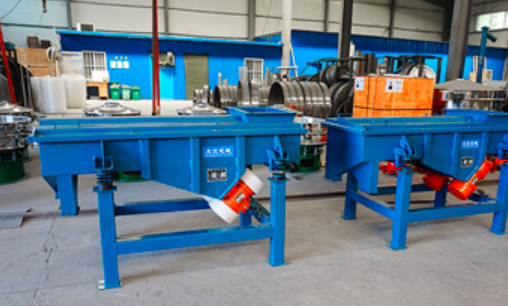In-Depth Guide to Vibratory Sieving Machines: Design, Benefits, and Applications

Introduction
Vibratory sieving machines are essential tools in various industries for the separation and classification of bulk materials. These machines use vibration to facilitate the efficient movement of materials through a mesh screen, allowing for precise separation based on particle size and shape. This comprehensive guide explores the design features, advantages, and applications of vibratory sieving machines, highlighting their critical role in optimizing material handling processes.
1. Understanding Vibratory Sieving Machines
A vibratory sieving machine is a device used to separate and classify materials through a vibrating screen. The vibration helps to distribute the material evenly across the screen, allowing particles of different sizes to pass through the mesh while larger particles are retained. This process is crucial for ensuring the quality and consistency of the materials being processed.
2. Key Design Features of Vibratory Sieving Machines
2.1 Construction Materials
Vibratory sieving machines are typically constructed from durable materials such as stainless steel or carbon steel. Stainless steel is preferred for its resistance to corrosion, ease of cleaning, and ability to maintain hygiene standards, especially in food and pharmaceutical industries.
2.2 Screening Surface
The screening surface of a Vibratory Sieving Machine consists of a mesh or perforated screen that can be customized to various mesh sizes. The choice of mesh size is crucial for achieving the desired separation and classification of particles. Screens are often designed to be easily replaceable to accommodate different processing needs.
2.3 Vibratory Mechanism
The vibratory mechanism is the core component of the sieving machine, generating controlled vibrations that promote the movement of material across the screen. This mechanism is typically powered by electric motors or vibrators. The frequency and amplitude of the vibrations can be adjusted to optimize performance for different materials.
Read also: Urethane casting machine: A Comprehensive Guide
2.4 Frame and Structure
The frame and structure of a vibratory sieving machine are designed to support the screening surface and vibratory mechanism. The frame must be robust to withstand the stresses generated by the vibrations and the weight of the material being processed. The structure is often designed to minimize vibration transmission to the surrounding environment.
2.5 Sanitary Features
For applications in food, pharmaceuticals, and other industries with stringent hygiene requirements, vibratory sieving machines are equipped with sanitary features such as smooth, non-porous surfaces, quick-release clamps, and removable covers. These features facilitate easy cleaning and maintenance, ensuring compliance with hygiene standards.
3. Benefits of Vibratory Sieving Machines
3.1 Efficient Material Separation
Vibratory sieving machines offer efficient and precise separation of materials based on particle size. The vibrating action ensures that particles are evenly distributed across the screen, allowing for effective classification and removal of oversized or undersized particles.
3.2 Versatility
These machines are versatile and can be used to process a wide range of materials, including powders, granules, and liquids. They can handle various particle sizes and types, making them suitable for diverse industrial applications.
3.3 Easy Maintenance
Vibratory sieving machines are designed for ease of maintenance. Features such as removable screens, quick-release clamps, and accessible components simplify cleaning and routine maintenance, reducing downtime and ensuring continuous operation.
3.4 Durability
Constructed from high-quality materials, vibratory sieving machines are built to endure the rigors of industrial environments. Their robust design ensures long-term performance and reliability, even under continuous use.
4. Applications of Vibratory Sieving Machines
4.1 Food Processing
In the food processing industry, vibratory sieving machines are used to screen and classify ingredients such as flour, sugar, spices, and grains. They help in removing contaminants, ensuring product quality, and maintaining hygiene standards.
4.2 Pharmaceuticals
Pharmaceutical companies use vibratory sieving machines to separate and classify active pharmaceutical ingredients (APIs), powders, and granules. The precision and hygiene features of these machines are critical for producing safe and effective medications.
4.3 Chemicals
In the chemical industry, vibratory sieving machines are employed to filter and classify chemical powders and granules. They ensure that the chemical products meet required specifications and help prevent contamination.
4.4 Plastics and Polymers
Vibratory sieving machines are used in the plastics and polymers industry to remove contaminants from raw materials and ensure the quality of finished products. They handle a variety of particle sizes and types, making them versatile for different applications.
5. Considerations for Choosing a Vibratory Sieving Machine
5.1 Material Characteristics
Evaluate the properties of the material to be processed, including particle size, flowability, and abrasiveness. Choose a sieving machine with the appropriate mesh size and construction materials to match these characteristics.
5.2 Size and Capacity
Determine the required size and capacity of the vibratory sieving machine based on the volume of material to be processed and the available space in your facility. Proper sizing ensures that the machine can handle the required throughput efficiently.
5.3 Regulatory Compliance
Ensure that the vibratory sieving machine complies with relevant industry regulations and standards for hygiene, safety, and performance. Verification of compliance is essential for industries subject to strict regulatory requirements.
5.4 Maintenance and Support
Select a machine from a reputable manufacturer that offers comprehensive support and maintenance services. Regular maintenance and prompt support are crucial for ensuring the continued efficiency and longevity of the equipment.
6. Maintenance and Troubleshooting
6.1 Regular Inspections
Conduct regular inspections to check for signs of wear, damage, or material build-up. Inspect the vibratory mechanism, screen, and other components to ensure that the machine is functioning correctly.
6.2 Cleaning Procedures
Follow recommended cleaning procedures to maintain hygiene and prevent contamination. Use appropriate cleaning agents and methods to ensure that the machine is thoroughly cleaned and sanitized.
6.3 Troubleshooting Common Issues
Address common issues such as uneven separation, vibration problems, or screen damage promptly. Identifying and resolving these issues quickly helps maintain optimal performance and prevents operational disruptions.
Conclusion
Vibratory sieving machines are essential for efficient and precise material separation in various industries. Their design, versatility, and ease of maintenance make them valuable components in material handling systems. By understanding their features and applications, businesses can select the right vibratory sieving machine to meet their needs, ensuring high-quality outcomes and compliance with regulatory standards.





